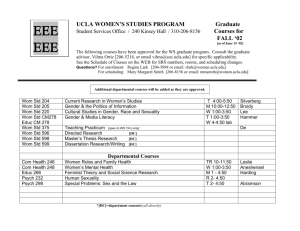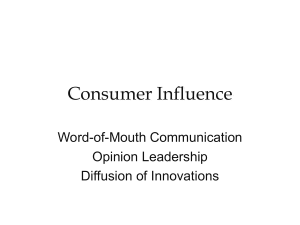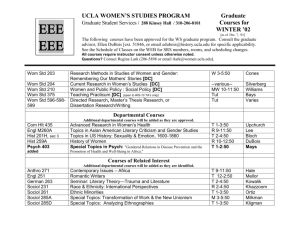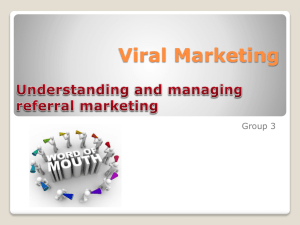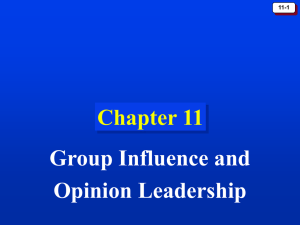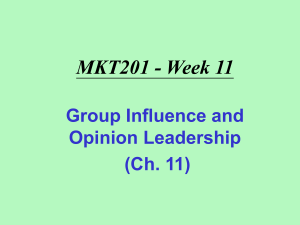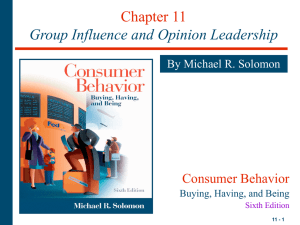Correlation between Word-of-Mouth Effects and New Media: Using Artificial Neural Network
advertisement
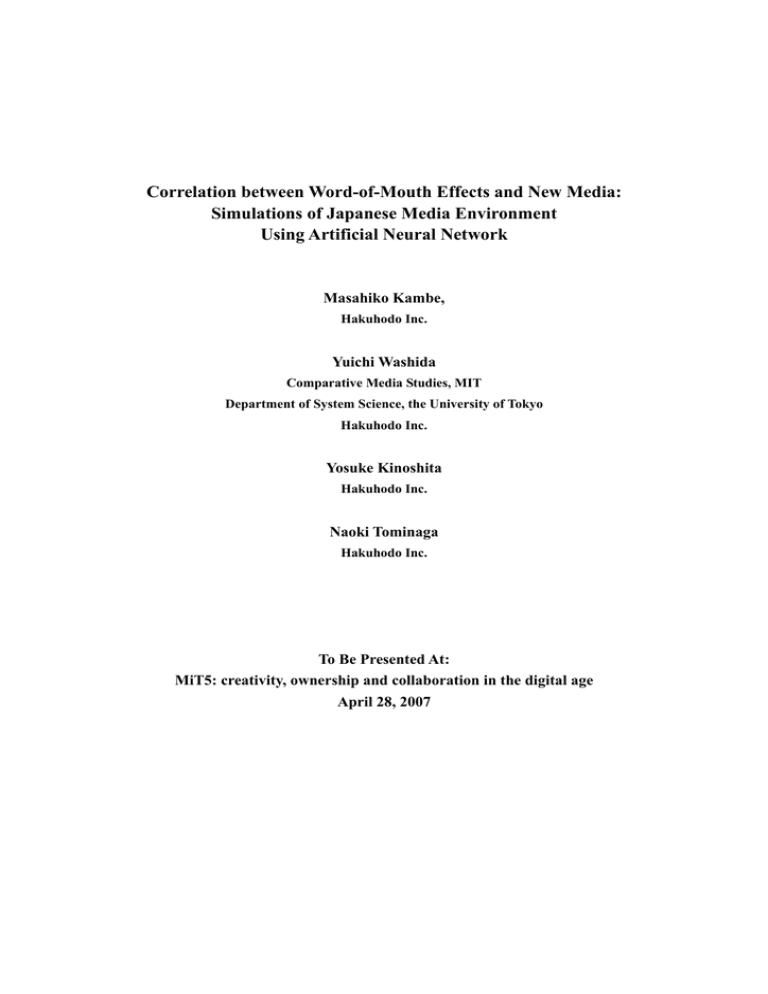
Correlation between Word-of-Mouth Effects and New Media: Simulations of Japanese Media Environment Using Artificial Neural Network Masahiko Kambe, Hakuhodo Inc. Yuichi Washida Comparative Media Studies, MIT Department of System Science, the University of Tokyo Hakuhodo Inc. Yosuke Kinoshita Hakuhodo Inc. Naoki Tominaga Hakuhodo Inc. To Be Presented At: MiT5: creativity, ownership and collaboration in the digital age April 28, 2007 Correlation between Word-of-Mouth Effects and New Media Abstract This study tries to discover new correlation patterns between word-of-mouth generation and other media effects through a computer simulation model by artificial neural network. First, authors conducted an empirical consumer survey in Japan regarding purchase behaviors of compact automotives, an example of typical consumption behaviors. Authors focused on each consumer’s media contact including conventional mass media, internet media, and communication through dealer activities. Second, based on this survey result, a computer simulation model was built to examine a variety of virtual settings of media environment surrounding current Japanese consumers. In building the model, authors used an artificial neural network system and manipulated each medium’s parameter. By observing the simulation results, authors tried to establish a new general pattern of media usages from the viewpoint of marketing practitioners to accelerate word-of-mouth effects. Today, although marketers notice that the word-of-mouth effects can have a great power in building an effective marketing strategy, they do not sufficiently understand collaborations between conventional marketing communication media and consumer-generated-media such as blogs and word-of-mouth activity. This experimental simulation study provides some basic hints to understand this collaboration. -2- Correlation between Word-of-Mouth Effects and New Media 1. Introduction and Motivation In the area of marketing studies, due to the wide penetration of information communication technologies, the influences of word-of mouth (WOM) effects have been focused as a new marketing technique. The original meaning of WOM is a behavior among people to communicate each other without any intentions or purposes. However, in marketing businesses, a new meaning of WOM is a type of new communication media that conveys information with particular intentions or purposes. We should be careful with this translation when we think of media environments. In the original meaning, it is spontaneous that WOM is an external element for media businesses. In fact, WOM is conventionally considered as one of the major reasons of the network effect, or the network externalities (Liebowitz 1994), and its behavior or result looks relatively random and uncontrollable (Arthur 1994). However, in this new meaning, we should think that WOM is one of the internal elements of marketing communication businesses. Assuming that WOM can be an internal element, we should consider that WOM can be amplified by the correlation with other media, including conventional mass media and new information communication technologies. This research stands on this viewpoint, and tries to examine correlations between every major medium and “touchpoint” (or marketing communication channels). That said, we must think that WOM still has two aspects from the viewpoint of marketing practitioners: “external” and “internal.” There are some unavoidable risks to harness WOM as a marketing medium, because an external aspect of WOM is not entirely manipulative. Thus, classifying various WOM communications into a few types based on characteristics and also understanding basic behaviors of each type of WOM can be an important first step to minimize risks. Because WOM is one of the basic reasons of the network effect, there is a limitation to simulate its behaviors by using conventional linear statistical planning models. Therefore, we decided to build a dynamic simulation model using a complex information system technology that can deal with multi-correlations among a variety of touchpoints and some consumer norms. 2. Previous Studies Word of Mouth and its Effect The Internet has broadened the area of WOM influences from interpersonal communication among acquaintances to online communication to general public (e.g. posting reviews). Harrison-Walker (2001) defined WOM as “informal person-to-person communication between a perceived noncommercial communicator and a receiver regarding a brand, a product, an -3- Correlation between Word-of-Mouth Effects and New Media organization, or a service.” Marketing practitioners try to encourage such “informal” communication in a positive manner, and several approaches such as “viral marketing” (Wilson 2000) and “buzz marketing” (Rosen 2000) have been developed. Some former studies have reported the positive effect of WOM. Chevalier and Mayzlin (2006) suggested “the addition of new, favorable reviews at one site results in an increase in the sales of a book at that site relative to the other site,” comparing Amazon.com and Barnesandnoble.com. They also found “customer reviews tend to be positive at both sites.” It is also suggested that the amount of WOM information at the Yahoo Movies Web site has explanatory power for box office revenue both in aggregate and for the early weeks (Liu 2006). Motivation behind WOM Several researchers have suggested motives for traditional WOM communications. Many suggested motives can be categorized as involvements with product or oneself, which are supposed to arise from experiences in using products. For example, Dichter (1966) categorized Product-involvement motive as a mean to reduce the tension caused by the consumption experience, and Self-involvement motive as a way to gratify some emotional needs. On the other hand, it is also suggested that marketing communication can arise WOM. Message-involvement (Dichter 1966) refers to discussion stimulated by advertisements or other marketing communications. Message intrigue (Engel, Blackwell and Miniard 1993) is defined as a motive of entertainment resulting from talking about certain ads. We noticed these entertainment motives from marketing communications and decided to examine how marketing communication on each touchpoint affects the occurrence of WOM. Motives for electric WOM (eWOM) have also been suggested. Henning-Thurau et al. (2004) pointed out “Social benefits” factor such as “it is fun to communicate this way with other people in the community” as well as “Platform assistance” factor, which is specific to eWOM. Phelps et al. (2004) listed top 3 motives for Sending Pass-Along Email, all of which are related to entertainment motives. 3. Hypotheses Since the advent of eWOM, WOM has played an important role for many marketing practitioners. Word of Mouth Marketing Association (WOMMA) distinguishes Amplified WOM from Organic WOM, which “occurs naturally when people become advocates because they are happy with a product and have a natural desire to share their support and enthusiasm.” This definition implies Organic WOM can arise from experiences in using products. On the other hand, -4- Correlation between Word-of-Mouth Effects and New Media Amplified WOM, which “occurs when marketers launch campaign designed to encourage or accelerate WOM,” does not necessarily need product usage. Our first step is to examine that marketing communication can amplify WOM. According to WOMMA, the definition of WOM marketing is 1) “giving people a reason to talk about your products and services” and 2) “making it easier for that conversation to take place.” We focus on this first step and try to find out which touchpoints can convey people a reason to talk about effectively. H1: The occurrence of WOM behavior is influenced by which touchpoints of brand/product information a person pays attention to. Our basic and the most important hypothesis is that there are two types of WOM, “gap WOM” and “common WOM”. Gap WOM is defined as communication to fill the information gap among communicators. This type of WOM can arise when a person possesses information advantages and finds a self-enhance motivation. We think utilizing gap WOM is similar to influencer marketing (Kelly and Berry 2003). Common WOM is defined as communication about common information. This type of WOM can arise when communicator share common information and talking about this brings entertainment. From the above definitions, we hypothesize that gap WOM can be amplified by touchpoints conveying a lot of information to give information advantages to a relatively small number of people and that common WOM can be amplified by touchpoints reaching a majority of people at a time. H2: Gap WOM and common WOM can be amplified by certain touchpoints. According to Phelps et al., advertisers strive to accomplish the tipping point (Gladwell 2000), which occurs when any social phenomenon reaches critical mass. We further research if there is a tipping point by simulating information experiences under different touchpoints circumstances. H3: If H1 and 2 are true, certain dynamic correlation patterns between each type of WOM and consumer norms, such as preferences, and purchase willingness should be observed when marketing practitioners manipulate each touchpoints. Moreover, if H3 is supported, we can build a general framework that explains the dynamic relation between each type of WOM and various consumer norms. This framework can help marketing practitioners build marketing strategies, working as an important standard to utilize WOM as manipulative marketing tools. -5- Correlation between Word-of-Mouth Effects and New Media 4. Methods Empirical Consumer Survey We conducted an empirical consumer survey using on-line survey system that collects responses from all over Japan. In this survey, we asked respondents to declare his or her recent experiences, opinions, sentiments, and feelings regarding compact automobile purchase activities. There are two major purposes of the survey. First, by confirming respondent’s viewership and readership toward each content or advertisement of compact automobiles in 34-type medium (Table 2), we obtained the actual correlation rate among each medium’s viewership or readership rate. Second, we also examined the consumer’s awareness rate, preference rate, and purchase willingness rate toward each particular compact automobile products, including Toyota Vitz (same as Yaris in EU), Nissan March (same as Micra in the US and EU), Nissan Cube, Mazda Demio ( same as Festiva mini-wagon in the US), and Honda Fit. The same data is used as the training data for an artificial neural network simulation model in the following examination. The detail of the survey is shown in Appendix1. From our empirical research, gap WOM is gauged by the questionnaire of “Do you advice your family, friends or online friends about automobile purchase decision?” (WOMadvice) In previous studies, it is supposed that influencers are 10% of any target market who frequently offer and are elicited for category-related advice by friends and colleagues (Marsden, Samson, and Upton 2005). Feick and Price (1987) investigated that “Market Maven” groups are good information diffuser recommending particular brands and products. Washida (2005) also showed that, in the Japanese marketplace, certain types of consumer communities can work as the influencers even though the community is not located in the initial stage of the diffusion process. Therefore, in this survey we decide to utilize this question to define the gap WOM. Similarly, the common WOM is gauged by the questionnaire of “Have you talked about (the brand) with your friends during the year?” (WOMbrand) Based on the survey data, we conducted a series of multinomial logit model analyses. This method examines the marginal effect of each subject variable, comparing correlations between object variables and every subject variable. The result of these analyses should examine our hypothesis H1 and H2. Simulation Model Using an Artificial Neural Network System To simulate complicated correlations among various media and consumer norms, we used an artificial neural network system. An artificial neural network (ANN) is an interconnected group of artificial neurons that uses a mathematical model or computational model for information processing. -6- Correlation between Word-of-Mouth Effects and New Media In most cases an ANN is an adaptive system that changes its structure based on external or internal information flowing through the network; thus, it realizes non-linear statistical data modeling. In this research, we used a “feedforward-type” ANN, an acyclic model, with 14 input variables, 4 output variables, and 9 variables in one hidden layer, shown in Figure 1. To utilize this simulation model, we need to define inputs and outputs referring the Japanese consumer media environment. Based on the empirical consumer survey, we chose 14 media touchpoints as the input variables. Also, we settled 4 elements as the output variables that consist of consumer preference rate, purchase willingness rate, gap WOM experience rate, and common WOM experience rate. To adapt the simulation model into the practical environment, we trained a lot of simulators by inputting all survey data and compared each simulator’s outputs with the actual numbers of 4 elements obtained through the same survey. If a simulator outputs relatively close to the actual numbers, we can consider that the simulator works well. However, many simulators could not precisely simulate the actual results. Simulators suffer the path dependence effects of the training process and over-fitting phenomenon of the ANN. It is a well-known weak point of ANN system. Therefore, in this research we built more than 100 simulators and chose the best fitted simulator, referring the fitness level to the actual output numbers. The result of the simulation should examine our hypothesis H 3. -7- Correlation between Word-of-Mouth Effects and New Media Figure 1: Structure of Artificial Neural Network System Touchpoint Amount of information media contacts concerning Vitz Simulator to study investigation result Consumer Norms Hidden layer Consumer norms concerning Vitz TV programs i1 TV ad i2 h1 Newspaper ad i3 h2 Article on car magazines i4 Ad on car magazines i5 Article on general magazines i6 Banner-type message on website i7 Website of the car manufacturer i8 Bulletin board system or blog o1 Brand preference rate o2 Brand purchase willingness o3 Common WOM o4 Gap WOM h3 h4 h5 i9 h6 Manufacturer and dealer's handbills i10 Catalog or brochure including videos and DVDs i11 h7 Banner or poster outside of the car dealers i12 h8 Communication with sales representatives i13 h9 Large showroom i14 -8- Correlation between Word-of-Mouth Effects and New Media 5. Result Analysis for Empirical Consumer Survey Here, we only used the empirical data regarding Toyota Vitz, because Vitz is the most successful compact automobile product in Japan and the data seem to represent the general tendencies of the Japanese automobile marketing practices. TABLE 1 Key Statistics % Total WOMadvice WOMvitz Correlation Coefficient 38.5% 29.7% Average Age Men 50.0% 66.0% 47.5% 0.2107 41.1 43.9 42.4 In order to examine H1 and H2, the following logit regression model is estimated: Gap WOM: Probability of WOMadvice = e ( CONSTANT + (1 + e ∑ anTOUCHPOINTn ) ( CONSTANT + ∑ anTOUCHPOINTn ) ) (1) Common WOM: Probability of WOMvitz = e ( CONSTANT + (1 + e ∑ anTOUCHPOINTn ) ( CONSTANT + ∑ anTOUCHPOINTn ) ) (2) where e is the natural logarithm base, an is coefficient, and touchpointn is a dummy variable (1 = a person paid attention to the car’s information of the touchpoint). Table 3 and 4 report the regression results. Model I to III consist of touchpoints of mass media, IV those of the Internet media, and V those of dealer activities. Coefficients of several touchpoints are significant, while others are not. Joint tests of Model I to V show that the occurrence of WOM behavior is influenced by touchpoints of mass media, the Internet media, and dealer activities respectively. As to common WOM analysis, while CMAGAD is significant in model II, it becomes insignificant in model III. To examine each touch point’s robustness, especially to avoid the -9- Correlation between Word-of-Mouth Effects and New Media omitted variable bias, model VI and VII were built both for gap WOM and common WOM. Model VII shows robust touchpoints. In order to examine H2, the marginal effects of each touchpoint on the probability of WOMadvice and WOMvitz were tested and we compared model VII of WOMadvice and that of WOMvitz (Table 5 and 6). According to the result of each model VII, seven touchpoints are robust in both models. TVAD, which can reach the largest number of people at a time, has significant effect on the probability of WOMvitz, while it doesn’t on the probability of WOMadvice. From this result, we conclude that common WOM can be amplified by touchpoints reaching a majority of people at a time. On the other hand, coefficients of CMAGAD and BBSBLOG are significant in WOMadvice model VII, while not in WOMvitz model VII. Moreover, the marginal effect of CMAGAR, which usually contains a lot of automobile information, has the largest effect. Since car magazines are targeted media and bulletin board systems or blogs have relatively narrow reach, this result may show that touchpoints with a lot of information but relatively narrow reach can give information advantages; thus, gap WOM can be amplified by these touchpoints. These results imply that our hypothesis H1 and H2 are supported. According to the analyses result, we observe significant correlations between viewership or readership and the emergence of each WOM. It means that WOM can be controlled at a certain degree by orchestrating consumers’ media environment. And we also observed clear contrast of emergence pattern between gap WOM and common WOM. It strongly implies that gap WOM and common WOM is qualitatively different from each other. - 10 - Correlation between Word-of-Mouth Effects and New Media TABLE 2 List of Variables Variable Name TVPRO TVAD NPAR NPAD CMAGAR CMAGAD MAGAR MAGAD RDAD BANWEB WEBMAN BBSBLOG FLIER DM CARDIS CATALOG POSOUT POSIN SALESREP TDRI SHOW (Touchpoints) Used in the Analyses and their contact ratios Meaning % Information on TV programs 7.8 TV ad 40.4 Article on newspaper 6.3 Newspaper ad 11.4 Article on car magazines 7.0 Ad on car magazines 2.4 Article on general magazines 4.5 Ad on general magazines 4.3 Ad on radio 1.3 Banner ad on websites 2.1 Website of the car manufacturer 10.9 Bulletin board system or blog 2.8 Flier of the car manufacturer or the car dealers 8.4 Direct mail from the car manufacturer or the car dealers 2.1 Car displayed at the car dealers 4.3 Catalog or brochure including videos or DVDs 3.5 Banner or poster outside of the car dealers 3.2 Poster or video clip inside of the car dealers 1.3 Communication with sales representatives 3.2 Test drive 2.9 Large showroom 1.6 - 11 - Correlation between Word-of-Mouth Effects and New Media TABLE 3 Gap WOM Logit Regression Results: The coefficients of touchpoints Model I Model II Model III Model IV TVPRO 0.5533 ** TVAD 0.0696 0.0560 0.0600 NPAR 0.1039 NPAD 0.5663 ** 0.5166 ** 0.4451 ** CMAGAR 1.6527 ** CMAGAD 1.7351 ** 1.2097 ** MAGAR 0.5721 ** MAGAD 0.0831 -0.1305 RDAD 0.6718 0.6211 BANWEB -0.0417 WEBMAN 0.9954 BBSBLOG 1.2206 FLIER DM CARDIS CATALOG POSOUT POSIN SALESREP TDRI SHOW Constant -0.5490 ** -0.5889 ** -0.7458 ** -0.5981 Log Likelihood -1348.0 -1331.1 -1282.5 -1320.2 Joint Test ** ** ** ** P < .05, * P < .10 - 12 - Model V ** ** ** ** 0.5325 0.4838 0.5004 0.2725 0.1574 0.2247 0.6876 0.2657 1.0919 -0.5956 -1327.9 ** ** ** ** ** ** Model VI 0.4813 -0.0154 -0.1274 0.3516 1.4862 0.9759 0.4740 -0.3388 0.6843 -0.4397 0.6828 0.7899 0.2353 0.4408 0.1002 -0.2170 0.1775 0.2070 0.7105 0.0260 1.0660 -0.8137 -1257.5 ** ** ** ** * ** ** Model VII 0.4621 0.3753 1.4844 0.9574 0.5005 ** ** ** ** ** 0.6533 ** 0.7815 ** ** 0.7487 ** ** 1.0601 -0.8057 -1262.5 ** ** - ** - Correlation between Word-of-Mouth Effects and New Media TABLE 4 Common WOM Logit Regression Results: The coefficients of touchpoints Model I Model II Model III Model IV Model V TVPRO 0.9586 ** TVAD 0.7964 ** 0.7744 ** 0.7830 ** NPAR 0.1669 NPAD 0.7692 ** 0.6800 ** 0.5850 ** CMAGAR 0.8001 ** ** CMAGAD 0.9354 0.3944 MAGAR 0.7768 ** MAGAD 0.7316 ** 0.5148 ** RDAD -0.1388 -0.3265 BANWEB 3.4900 ** WEBMAN 8.3700 ** BBSBLOG 2.8200 ** FLIER 0.7390 DM 0.3085 CARDIS 0.7584 CATALOG 1.1988 POSOUT 0.9928 POSIN 0.4367 SALESREP 0.8472 TDRI 0.4766 SHOW 1.7719 Constant -1.3131 ** -1.3499 ** -1.5100 ** -19.6200 ** -1.1297 Log Likelihood -1183.4 -1172.5 -1138.5 -1183.8 -1161.4 Joint Test ** ** ** - 13 - ** ** ** ** ** ** ** ** ** Model VI 0.7824 0.6555 -0.1834 0.4317 0.4433 0.1806 0.6329 0.1383 -0.4359 0.6217 0.8194 0.5593 0.2577 0.3157 0.3658 0.8274 0.7701 0.3590 0.8405 0.3383 1.6845 -1.6386 -1089.2 ** ** ** Model VII 0.8356 0.6916 ** ** 0.4996 0.5693 ** 0.7421 ** 0.8678 ** 0.9092 0.8206 ** ** 1.0755 ** ** 1.7382 -1.6180 -1096.5 ** ** ** ** * ** * ** ** ** - ** ** - Correlation between Word-of-Mouth Effects and New Media TABLE 5 The Marignal Effects of Touchpoints on the Probability of WOMadvice Model I Model II Model III Model IV TVPRO 13.6% ** TVAD 1.7% 1.3% 1.4% NPAR 2.5% NPAD 13.9% ** 12.6% ** 10.9% ** CMAGAR 38.6% ** ** CMAGAD 39.7% 29.2% ** MAGAR 14.1% ** MAGAD 2.0% -3.1% RDAD 16.6% 15.3% BANWEB -1.0% WEBMAN 24.4% BBSBLOG 29.5% FLIER DM CARDIS CATALOG POSOUT POSIN SALESREP TDRI SHOW ** P < .05, * P < .10 - 14 - Model V ** ** 13.1% 11.9% 12.3% 6.6% 3.8% 5.4% 17.0% 6.5% 26.6% ** ** ** ** Model VI 11.8% -0.4% -3.0% 8.6% 35.2% 23.9% 11.6% -7.7% 16.9% -9.9% 16.8% 19.5% 5.7% 10.8% 2.4% -5.0% 4.3% 5.0% 17.5% 0.6% 26.0% ** ** Model VII 11.3% ** 9.2% 35.2% 23.5% 12.3% ** 16.0% 19.3% ** ** 18.5% ** ** 25.9% ** ** ** * ** ** ** ** ** ** Correlation between Word-of-Mouth Effects and New Media TABLE 6 The Marignal Effects of Touchpoints on the Probability of WOM vitz Model I Model II Model III Model IV TVPRO 22.1% ** TVAD 16.7% ** 16.2% ** 16.3% ** NPAR 3.5% NPAD 17.4% ** 15.2% ** 12.9% ** CMAGAR 18.2% ** ** CMAGAD 21.8% 8.6% MAGAR 17.8% ** MAGAD 16.7% ** 11.4% * RDAD -2.8% -6.2% BANWEB 27.3% WEBMAN 29.2% BBSBLOG 19.3% FLIER DM CARDIS CATALOG POSOUT POSIN SALESREP TDRI SHOW ** P < .05, * P < .10 - 15 - Model V ** ** ** 16.9% 6.8% 17.5% 28.4% 23.4% 9.8% 19.7% 10.7% 41.6% ** ** ** ** ** ** Model VI 17.7% 13.6% -3.6% 9.3% 9.7% 3.8% 14.2% 2.9% -8.0% 14.0% 18.5% 12.5% 5.5% 6.8% 7.9% 19.0% 17.6% 7.8% 19.4% 7.3% 39.7% ** ** ** Model VII 19.0% 14.4% ** ** 10.9% 12.6% ** ** 16.9% ** ** 19.7% ** ** 21.0% 18.9% ** ** 25.2% ** ** 40.8% ** ** ** ** ** Correlation between Word-of-Mouth Effects and New Media Simulations by an Artificial Neural Network System Next, a series of ANN simulations was conducted by examining the best simulators. The simulation results are shown in Table 7 and Table 8, which indicate the simulation result summary about dynamic relations between the consumer norms and each of WOM, when the amount of information on touchpoint increases. The purpose of these simulations was to explore dynamic correlation patterns between two types of WOM and consumer norms. We found that the consumer preference rates and purchase willingness rates usually follows the emergence rate of common WOM whenever consumer’s viewership or readership changes. A typical example of dynamic relations between the consumer norms and common WOM is shown in Figure 2. It means amplifying common WOM regarding one product can increase its brand assets. In that case, conventional mass media communication efficiently works by accelerating the amplification of common WOM. Conversely, regarding gap WOM, consumer’s preference rate and purchase willingness rate do not follow its tendency when viewership or readership changes. In some cases, they look to move to the other way around. A typical conflicting relation is shown in Figure 3. It means gap WOM may even decrease the brand assets when marketing practitioners try to utilize gap WOM as a marketing tool. Probably, it is because that gap WOM includes some critics from knowledgeable consumers and is also influential to other mass consumers. We have also found that the increase of CMAGAD, BBSBLOG, and SHOW touchpoints can amplify gap WOM, while the increase of BANWEB, CATALOG, SALESREP touchpoints tend to decrease it. CMAGAR can stimulate gap WOM even though the result seems to be uncontrollable. In these simulations we could not find any general pattern of dynamic correlation between gap WOM and typical mass media ad, such as TVPRO, TVAD, and NPAD. It means that, contrastively to common WOM, gap WOM should be considered as a relatively “external” element from the viewpoint of marketing practitioners. Thus, we should say our hypothesis H3 is not fully supported. - 16 - Correlation between Word-of-Mouth Effects and New Media TABLE 7 Simulation result summary 1 Comparison of change Comparison of change direction between direction between consumer consumer norms and gap norms and common WOM WOM 1.TV program same different 2.TV ad same different 3.Nwespaper ad same same 4. Article on car magazines same same 5. Ad on car magazines same same 6. Article on general magazines same different 7. Banner-type message on website same different 8. Website of the car manufacturer same different 9. Bulletin board system or blog same same 10. Manufacturer and dealer's handbills same same 11. Catalog or brochure including videos and D same same 12. Banner or poster outside of the car dealers same same 13. Communication with sales representatives same same 14. Large showroom same same - 17 - Correlation between Word-of-Mouth Effects and New Media TABLE 8 Simulation result summary 2 1.TV program 0 0.0% 0.0% 0.0% 0.0% 0.2 -0.1% -0.2% 1.5% -7.8% 0.4 -0.1% -0.2% 3.0% -15.8% 0.6 -0.1% -0.3% 4.6% -23.9% 0.8 0.2% -0.1% 6.2% -30.5% 5.6% 4.0% 7.5% -10.8% 0.0% 0.0% 0.0% 0.0% 0.2 0.0% 0.1% 0.3% -3.6% 0.4 0.0% 0.2% 0.7% -7.1% 0.6 -0.2% 0.2% 0.9% -10.6% 0.8 -0.4% 0.2% 1.2% -14.0% 1 -0.6% 0.0% 1.4% -17.4% 0.2 0.7% 0.5% 0.2% 0.4% 0.4 1.4% 1.0% 0.5% 0.7% 0.6 2.1% 1.4% 0.7% 0.8% 0.8 2.7% 1.8% 0.9% 0.9% 1 0.0% 0.0% 0.0% 0.0% 0.0% 0.0% 0.0% 0.0% 0.2 5.7% 4.1% 1.0% 12.0% 0.4 11.3% 8.0% 1.9% 23.7% 0.6 16.5% 11.8% 2.8% 34.4% 0.8 21.3% 15.3% 3.7% 43.5% 1 25.7% 18.6% 4.7% 50.2% 0.0% 0.0% 0.0% 0.0% 0.2 2.2% 1.7% 0.5% 2.8% 0.4 4.4% 3.3% 1.1% 5.6% 0.6 6.6% 5.0% 1.6% 8.5% 0.8 8.8% 6.7% 2.1% 11.3% 1 10.9% 8.3% 2.6% 14.1% 0.0% 0.0% 0.0% 0.0% 0.2 -0.2% -0.1% -0.7% 2.2% 0.4 -0.4% -0.3% -1.3% 4.4% 0.6 -0.7% -0.5% -2.0% 6.7% 0.8 -1.0% -0.7% -2.7% 8.9% 1 -1.3% -0.9% -3.4% 11.0% 7. Banner-type message on website 0 Vitz preference 0.0% Vitz purchase willingness 0.0% Vitz common WOM 0.0% Vitz gap WOM 0.0% 0.2 0.7% 0.6% 0.8% -3.1% 0.4 1.9% 1.6% 1.9% -6.9% 0.6 4.9% 4.2% 3.9% -12.7% 0.8 12.0% 10.6% 8.0% -23.1% 1 23.1% 20.7% 14.2% -38.8% Vitz Vitz Vitz Vitz preference purchase willingness common WOM gap WOM 1 2.TV ad 0 Vitz Vitz Vitz Vitz preference purchase willingness common WOM gap WOM 3.Nwespaper ad 0 Vitz Vitz Vitz Vitz preference purchase willingness common WOM gap WOM 3.3% 2.2% 1.2% 0.9% 4. Article on car magazines 0 Vitz Vitz Vitz Vitz preference purchase willingness common WOM gap WOM 5. Ad on car magazines 0 Vitz Vitz Vitz Vitz preference purchase willingness common WOM gap WOM 6. Article on general magazines 0 Vitz Vitz Vitz Vitz preference purchase willingness common WOM gap WOM - 18 - Correlation between Word-of-Mouth Effects and New Media 8. Website of the car manufacturer 0 Vitz preference 0.0% Vitz purchase willingness 0.0% Vitz common WOM 0.0% Vitz gap WOM 0.0% 0.2 1.5% 1.0% 0.1% 2.7% 0.4 2.6% 1.7% 0.2% 5.3% 0.6 3.4% 2.2% 0.1% 7.6% 0.8 3.8% 2.3% -0.1% 9.6% 1 0.0% 0.0% 0.0% 0.0% 0.2 6.9% 4.8% 1.2% 17.7% 0.4 14.1% 10.0% 2.6% 34.4% 0.6 22.3% 16.2% 4.7% 47.1% 0.8 33.6% 25.5% 8.9% 52.5% 1 48.0% 37.8% 15.0% 49.8% 10. Manufacturer and dealer's handbills 0 Vitz preference 0.0% Vitz purchase willingness 0.0% Vitz common WOM 0.0% Vitz gap WOM 0.0% 0.2 -0.4% -0.4% 0.3% -0.4% 0.4 -0.8% -0.8% 0.6% -0.8% 0.6 -1.2% -1.2% 0.9% -1.2% 0.8 -1.7% -1.7% 1.2% -1.7% 1 -2.3% -2.3% 1.4% -2.1% 11. Catalog or brochure including videos and DVDs 0 0.2 Vitz preference 0.0% -2.9% Vitz purchase willingness 0.0% -2.0% Vitz common WOM 0.0% -1.1% Vitz gap WOM 0.0% -5.1% 0.4 -5.7% -3.9% -2.2% -9.8% 0.6 -8.3% -5.7% -3.3% -14.0% 0.8 -10.8% -7.4% -4.3% -17.7% 1 -13.1% -8.9% -5.4% -20.8% 12. Banner or poster outside of the car dealers 0 0.2 Vitz preference 0.0% 0.6% Vitz purchase willingness 0.0% 0.4% Vitz common WOM 0.0% 0.3% Vitz gap WOM 0.0% -0.7% 0.4 1.2% 0.9% 0.7% -1.5% 0.6 1.8% 1.3% 1.0% -2.3% 0.8 2.4% 1.7% 1.4% -3.2% 13. Communication with sales representatives 0 0.2 Vitz preference 0.0% -2.9% Vitz purchase willingness 0.0% -2.1% Vitz common WOM 0.0% -0.8% Vitz gap WOM 0.0% -4.1% 0.4 -5.5% -3.8% -1.5% -8.4% 0.6 -6.9% -4.6% -1.5% -13.4% 0.8 -5.8% -3.1% -0.4% -20.6% 1 -0.4% 2.2% 2.8% -31.4% 0.4 4.6% 3.1% 1.5% 7.6% 0.6 6.8% 4.7% 2.3% 11.3% 0.8 9.0% 6.2% 3.0% 14.9% 1 11.1% 7.6% 3.7% 18.2% 3.8% 2.1% -0.4% 11.5% 9. Bulletin board system or blog 0 Vitz Vitz Vitz Vitz preference purchase willingness common WOM gap WOM 1 2.9% 2.1% 1.7% -4.1% 14. Large showroom 0 Vitz Vitz Vitz Vitz preference purchase willingness common WOM gap WOM 0.0% 0.0% 0.0% 0.0% 0.2 2.3% 1.6% 0.8% 3.8% - 19 - Correlation between Word-of-Mouth Effects and New Media Figure 2: Typical results of common WOM *Horizontal axis:Standard deviation of the amount of information on touchpoint Vitz preference rate Vitz purchase willingness 【TV programs】 Vitz commonWOM 【TV ad】 20.0% 20.0% 15.0% 15.0% 10.0% 10.0% 5.0% 5.0% 【Article on car magazines】 30.0% 25.0% 20.0% 15.0% 10.0% 5.0% 0.0% 0.0% 0 0.2 0.4 0.6 0.8 1 0 0.2 0.4 0.6 0.8 0.0% 1 -5.0% -5.0% -5.0% -10.0% -10.0% -10.0% 0 0.2 0.4 0.6 0.8 1 Figure 3: Typical results of gap WOM *Horizontal axis:Standard deviation of the amount of information on touchpoint Vitz preference Vitz purchase willingness Vitz GapWOM 【Communication with sales representatives】 【Article on car magazines】 【TV programs】 30.0% 10.0% 20.0% 0.0% 50.0% 40.0% 0 10.0% 0.2 0.4 0.6 0.8 1 -10.0% 30.0% -20.0% 20.0% -30.0% 10.0% -40.0% 0.0% 0.0% -10.0% -20.0% -30.0% 0 0.2 0.4 0.6 0.8 1 0 - 20 - 0.2 0.4 0.6 0.8 1 Correlation between Word-of-Mouth Effects and New Media 6. Conclusion, Further Discussion, and Limitation Supposing that the emergence of WOM among consumers can be utilized as a part of marketing techniques, even WOM can be an indirect element for marketing practitioners. We made three hypotheses to examine if WOM could be manipulated by other media effects. To explain these hypotheses, we conducted an empirical survey for Japanese consumers, and analyzed the results by multinomial logit regression analysis and ANN dynamic simulation. We reached the conclusion that the occurrence of WOM can be amplified by marketing communications and that gap WOM is qualitatively different from common WOM in relationship with marketing communications (H1 and H2). However, H3, which suggests the possibility of creating a robust framework to manipulate WOM as a new marketing medium that can generate particular consumer norms as intended, was not fully supported. Summing up, we assume that amplifying common WOM can be a part of marketing strategy because it controllably accelerates positive consumer norms when marketing practitioners manipulate media touchpoints. However, we should be also noticed that gap WOM looks a “double-edged sword” in marketing planning. Even though gap WOM can be a new element to generate consumer’s recommendation behaviors besides conventional advertising, it also looks uncontrollable and it may sometimes work to decrease positive consumer norms. Our result suggests that the gap WOM behaviors can explain the “influencer” effects that should be separated from conventional mass marketing. Further discussions and researches are necessary to explore detailed relations between consumer norms, gap WOM behaviors, and “influencer” effects, when other media touchpoints are dynamically controlled. We can assume the possibility of “brand-based gap WOM” as a liner extension of this research. The concept of “brand-based gap WOM” may be an important clue to fill the vacuum between consumer norms and “influencer” effects. Our research focuses only on Japanese consumers’ automobile purchase behaviors, and there is a limitation to adopt the results into other areas or other product categories. Media environment in one country is strongly affected by political, cultural, and technological aspects of that country, and WOM also exists in consumer’s daily life. We must consider those externalities even if a part of WOM can be considered as the internal element of the media and marketing business. - 21 - Correlation between Word-of-Mouth Effects and New Media References Arthur, W. B. (1994) Increasing Returns and Path Dependence in Economy, The University of Michigan Press, Ann Arbor, MI. Bowman, D., and Narayandas, D. (2001) “Managing Customer-Initiated Contacts with Manufacturers: The Impact on Share of Category Requirements and Word-of-Mouth Behavior,” Journal of Marketing Research, Vol.38, No.3, p281-297 Brown, T. J., Barry, T. E., Dacin, P. A., and Gunst, R. F. (2005) “Spreading the Word: Investigating Antecedents of Consumer’s Positive Word-of-Mouth Intentions and Behaviors in a Retailing Context,” Journal of the Academy of Marketing Science, Vol.33, No.2, p123-138 Chevalier, J. D., and Mayzlin. D. (2006) “The Effect of Word of Mouth on Sales: Online Book Reviews,” Journal of Marketing Research, Vol. 43, No.3, p 345-354 Duhan, D. F., Johnson, S.D., Wilcox, J. B., and Harrell, G. D. (1997) “Influences on Consumer Use of Word-of-Mouth Recommendation Sources,” Journal of the Academy of Marketing Science, Vol.25, No.4, p283-295 Feick, F. L., and Price, L. L., (1987) “The Market Maven: A Diffuser of Marketplace Information,” Journal of Marketing, No. 51, pp83-97. Fong, J. and Burton, S. (2006) “Online word-of –mouth: a comparison of American and Chinese discussion boards,” Asia Pacific Journal of Marketing, Vol.18, No.2, p146-156 Gladwell, M, (2000), The Tipping Point: How Little Things Can Make a Big Difference, Little Brown & Co. Henning-Thurau, T., Gwinner, K. P., Walsh, G., and Gremler, D. D. (2004) “Electronic Word-of-Mouth via Consumer-Opinion Platforms: What Motives Consumers to Articulate Themselves on the Internet?,” Journal of Interactive Marketing, Vol.18, No.1 Hogan, J. E., Lemon, K. N., and Libai, B., (2004) “Quantifying the Ripple: Word-of-Mouth and Advertising Effectiveness,” Journal of Advertising Research, Vol.44 p 271-280 Keller, E., and Berry, J. (2003) The Influentials, The Free Press, NY Liebowitz, S. (1994) “Network Externality: An Uncommon Tragedy,” Journal of Economic Perspectives, Vol. 8, No. 2, p133-150. Liu, Y. (2006) “Word of Mouth for Movies: Its Dynamics and Impact on Box Office Revenue,” Journal of Marketing, Vol. 70, p74-89. Marsden, P., Samson, A., Upton, N., (2005) “Advocay Drives Growth,” London School Economics, September 13, 2005 Phelps, J. E., Lewis, R., Mobilio, L., Perry, D., Raman, N., (2004) “Viral Marketing or Electronic Word-of-Mouth Advertising: Examining Consumer Responses and Motivations to Pass Along Email,” Journal of Advertising Research, December 2004 P333-348 - 22 - Correlation between Word-of-Mouth Effects and New Media Rosen, E. (2000) “The Anatomy of Buzz How to Create Word-of-Mouth Marketing” Currency Sheer, L. K., and Stern, L. W. (1992) “The Effect of Influence Type and Performance Outcomes on Attitude Toward the Influencer,” Journal of Marketing Research, Vol.29, No.1, p128-142 Subramani, M. R., and Rajagopalan, B. (2003) “Knowledge-Sharing and Influence in Online Social Networks via Viral Marketing,” Communications of the ACM, Vol.46, No.12 Washida, Y. (2005) “Collaborative Structure between Japanese High-Tech Manufacturers and Consumers,” Journal of Consumer Marketing, Volume 22, No.1, p24-35. Wilson, R. F., (2000) “The Six Simple Principles of Viral Marketing,” Web Marketing Today, Issue 70, February 1, 2000 - 23 - Correlation between Word-of-Mouth Effects and New Media Appendix 1: Design of the Empirical Consumer Survey Survey name: Diffusion Dynamics Survey 2006 – automobile (DD 2006-auto) Survey location and the effective sample populations: the all over Japan, 2060 samples Respondents: ordinary individual men and women living, in Japan and owning a driving license, aged 18-69 Sampling procedure: internet consumer survey panels, provided by a professional survey company, were used. Response result: 19000 of calls for the survey are done and 9428 accesses are recognized (total access rate was 49.6%). The 6572 effective responses are collected, while 2856 incomplete or inappropriate responses are eliminated (total response rate was 69.7%). According to the distribution setting by age and gender, 2060 samples are randomly selected in the effective responses. Distribution of samples among age and gender groups: 20.0% of aged 18-29, 30-39, 40-49, 50-59, and 60-69. Male: Female rate is 1: 1 Survey date: Sep. 1, to 2, 2006 Appendix 2: Design of the Simulation System Simulator name: WOM simulator 2006- compact automobile Computational framework: Feedfoward-type artificial neural network Parameters: *Refer to the Figure 1. 14 inputs: i1: TV program, i2: TV ad, i3: Newspaper ad, i4: Article on car magazine, i5: Ad on car magazine, i6: Article on general magazine, i7: Banner-type message on website, i8: Website of the car manufacturers, i9: Bulletin board system or blog, i10: Manufacturer and dealer’s handbills, i11: Catalog or brochure including videos or DVDs, i12: Banner or poster outside of the car dealers, i13: Communication with sales representatives, i14: Large showroom, 4 outputs: o1: Brand preference rate, o2: Brand purchase willingness rate, o3: Common WOM emergence rate, o4: Gap WOM emergence rate (9 nodes in the hidden layer) Training procedure and fitness measurement: For each simulator all of 2110 samples’ touchpoint data was inputted 50 times. The inputting order was randomly changed for every simulator. By inputting the touchpoint data, weight values for each node and link were calculated by JMP version 5.1.1 Japanese edition. After the calculation, the - 24 - Correlation between Word-of-Mouth Effects and New Media outputs of the simulation were compared with the actual average values in all 2110 samples. Simulation and observation procedure: The normalized viewership or readership rates were virtually increased by the step of 0.2 SD in the input section of the simulator, and the simulative transition of each output parameter was recorded. Calculated weights for each link and node: h1:-8.649293106, h2:25.23434907, h3:6.138590615, h4:-0.610247226, h5:-0.323728432, h6:-0.427440759, h7:1.534185176, h8:0.556244997, h9:-16.78399273 h1-i1: -2.764873581, h1-i2: 0.847965198, h1-i3: -8.433782048, h1-i4: 4.294802199, h1-i5: 2.658524601, h1-i6:1.299323516, h1-i7: 5.116079257, h1-i8: -2.721219327, h1-i9: 4.694507411, h1-i10: -0.212684018, h1-i11: -0.140774266, h1-i12: -4.565609454, h1-i13: 0.840124253, h1-i14: -1.129013908 h2-i1: -17.3353257, h2:-i2:-15.84694596, h2-i3: 2.837886918, h2-i4: 7.978193525, h2-i5: -0.85161159, h2-i6: 7.569300193, h2-i7: -0.895347768, h2-i8: 17.39653552, h2-i9: -0.79247069, h2-i10: -10.66108767, h2-i11: 10.25145051, h2-i12: -2.351795642, h2-i13: -6.398295101, h2-i14: -10.59725151 h3-i1:6.209285541, h3-i2:1.535498302, h3-i3:14.98752557, h3-i4: -3.63722472, h3-i5: 1.962664004, h3-i6: -1.363758984, h3-i7: -6.488008785, h3-i8: 2.911923456, h3-i9: -6.503851375, h3-i10: -1.244656782, h3-i11: 2.678518512, h3-i12: 7.315115038, h3-i13: -5.571682461, h3-i14: 2.160783184 h4-i1: 0.070781776, h4-i2: -0.301795186, h4-i3: 462280533, h4-i4: 0.123105494, h4-i5: -0.073613488, h4-i6: 0.320876304, h4-i7: 0.223029663, h4-i8: 0.30745616, h4-i9: -0.294605875, h4-i10: -0.445598923, h4-i11: 0.435873541, h4-i12: 0.133507934, h4-i13: -0.477885577, h4-i14: -0.012832247 h5-i1: 0.257622595, h5-i2: -0.558612275, h5-i3: 0.425006866, h5-i4: 1.600231222, h5-i5: 0.245124874, h5-i6: -0.00223633, h5-i7: 0.164862435, h5-i8: 0.562870901, h5-i9: 2.220262718, h5-i10: 0.177646432, h5-i11: -1.011250055, h5-i12: 0.142659523, h5-i13: -1.043954992, h5-i14: 0.847573271 h6-i1: -0.05100134, h6-i2: 0.016645304, h6-i3: 0.226224091, h6-i4: 0.246450433, h6-i5: 0.032936806, h6-i6: 0.18724231, - 25 - Correlation between Word-of-Mouth Effects and New Media h6-i7: 0.073067288, h6-i8: 0.338023343, h6-i9: -0.155599412, h6-i10: -0.32534727, h6-i11: 0.219556544, h6-i12: 0.118170082, h6-i13: -0.240922447, h6-i14: 0.015576763 h7-i1: -0.083412196, h7-i2: -0.27230324, h7-i3: -0.150234463, h7-i4: -0.549678535, h7-i5: -0.003908296, h7-i6: -0.076335676, h7-i7: 0.01350723, h7-i8: -0.688879904, h7-i9: 0.001805984, h7-i10: 0.19486397, h7-i11: 0.078042718, h7-i12: -0.196397749, h7-i13: 0.152598599, h7-i14: -0.196620886 h8-1: -0.67448801, h8-i2: -0.065246403, h8:i3: -0.487249629, h8-i4: -0.383781262, h8-i5: -0.029310298, h8-i6: -0.043571365, h8-i7: -0.412121122, h8-i8: -0.567315707, h8-i9: 0.265439172, h8-i10: 0.313284806, h8-i11: -0.078970069, h8-i12: -0.308333624, h8-i13: 0.618270141, h8-i14: -0.235342865 h9-i1: 15.99669508, h9-i2: -2.032211119, h9-i3: -3.430074343, h9-i4: 5.322125358, h9-i5: -5.522750614, h9-i6: -7.433493318, h9-i7: 9.733180324, h9-i8: 0.869268153, h9-i9: 1.367816283, h9-i10: 4.666081225, h9-i11: -9.11010392, h9-i12: 1.175672573, h9-i13: 10.8286161, h9-i14: -3.612790877 o1:-6.910834416, o2:-6.688377955, o3:-1.292653066, o4:-4.18395289 o1-h1: -1.97396254, o1-h2: 0.356749992, o1-h3: -1.135759525, o1-h4:-6.85778583, o1-h5: 1.906895591, o1-h6: 11.92907387, o1-h7: 6.710753268, o1-h8: -1.319699343, o1-h9: 0.536451554 o2-h1: -1.862562194, o2-h2: 0.372950526, o2-h3: -1.245588015, o2-h4: -6.612387885, o2-h5: 1.637665782, o2-h6: 11.62829926, o2-h7: 6.625699149, o2-h8: -1.309768511, o2-h9: 0.507695597 o3-h1: -0.750335167, o3-h2: 1.194663169, o3-h3: -0.723754301, o3-h4: -2.875548485, o3-h5: 0.412649159, o3-h6: 2.079294936, o3-h7: 2.879973172, o3-h8: -2.302507755, o3-h9: -0.036882846 o4-h1: -0.363072098, o4-h2: -0.537902069, o4-h3: 0.372010422, o4-h4: -1.205894981, o4-h5: 1.500135366, o4-h6: 5.174629901, o4-h7: 0.921588989, o4-h8: 2.370875214, o4-h9: 0.910489658 - 26 - Correlation between Word-of-Mouth Effects and New Media About the Authors KAMBE, Masahiko Masahiko Kambe joined Hakuhodo, an advertising company in 1995 and served as a marketing planner working for clients from a variety of industries including automobile, soft drink, and fast food. Currently, he is in business development department and engages in new media development projects. Kambe holds a degree of Bachelor of Commerce and Management from Hitotsubashi University, and an MBA with distinction from Kellogg School of Management, Northwestern University. (Corresponding address: Hakuhodo Inc., 3-4-1 Grand Park Tower 30F, Shibaura, Minato-ku, Tokyo 108-8088, Japan. Phone: +81-3-5446-6152. Fax: +81-3-5446-6190. e-mail: masahiko.kanbe@hakuhodo.co.jp) WASHIDA, Yuichi Yuichi Washida, research affiliate in the Comparative Media Studies at Massachusetts Institute of Technology, 77 Massachusetts Avenue, Cambridge, 02139 MA, USA, and PhD. candidate, is with the Department of System Sciences at the University of Tokyo, 3-8-1 Komaba, Meguro-ku, Tokyo 153-8902, Japan, Washida has written several books regarding information technology and society. He conducted the joint research project with Ericsson ConsumerLab regarding “Early Adopters” (2002), as well as participated in the joint research project Cabinet Office of Japanese Government regarding “Japan’s e-life” (2000). KINOSHITA, Yosuke Yosuke Kinoshita, consultant at Hakuhodo Foresight, is with Hakuhodo Inc., 3-4-1 Grand Park Tower 11F, Shibaura, Minato-ku, Tokyo 108-8088, Japan. (e-mail: yosuke.kinoshita@hakuhodo.co.jp) TOMINAGA, Naoki Naoki Tominaga, consultant at Hakuhodo Foresight, is with Hakuhodo Inc., 3-4-1 Grand Park Tower 11F, Shibaura, Minato-ku, Tokyo 108-8088, Japan. (e-mail: naoki.tominaga@hakuhodo.co.jp) - 27 -

